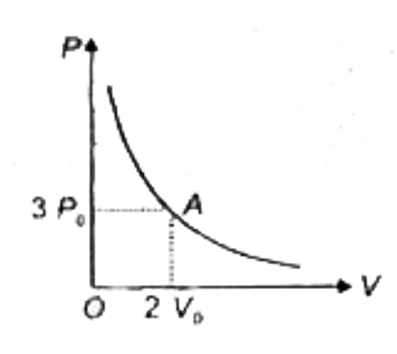The relation between internal energy , pressure and volume of a gas in an adiabatic process is
where a and b are constants. What is the effective value of adiabatic constant ?
1.
2.
3.
4.
The correct Answer is:B
To find the effective value of the adiabatic constant γ given the relation between internal energy U, pressure P, and volume V of a gas in an adiabatic process as U=a+bPV, where a and b are constants, we can follow these steps:
1. Understand the Adiabatic Process:
In an adiabatic process, there is no heat exchange, which means δQ=0. According to the first law of thermodynamics, this implies:
dU=−dW
2. Express Change in Internal Energy:
The change in internal energy dU for an ideal gas can be expressed as:
dU=nCvdT
where Cv is the molar heat capacity at constant volume.
3. Relate Cv to γ:
We know that:
Cv=Rγ−1
where R is the universal gas constant.
4. Substitute Cv into dU:
Substituting Cv into the expression for dU:
dU=nRγ−1dT
5. Integrate to Find Internal Energy:
Integrating dU gives us:
U=nRγ−1T+C
where C is the integration constant.
6. Use the Ideal Gas Law:
From the ideal gas law, we have:
PV=nRT⟹nRT=PV
Substituting this into the expression for U:
U=PVγ−1+C
7. Compare with Given Relation:
The problem states that:
U=a+bPV
By comparing both expressions for U:
PVγ−1+C=a+bPV
This implies:
- The coefficient of PV gives us:
1γ−1=b
- The constant terms give us:
C=a
8. Solve for γ:
Rearranging 1γ−1=b:
γ−1=1b⟹γ=1b+1
Thus, we can express γ as:
γ=b+1b
Final Result:
The effective value of the adiabatic constant γ is:
γ=b+1b
In an adiabatic process, there is no heat exchange, which means δQ=0. According to the first law of thermodynamics, this implies:
dU=−dW
The change in internal energy dU for an ideal gas can be expressed as:
dU=nCvdT
where Cv is the molar heat capacity at constant volume.
We know that:
Cv=Rγ−1
where R is the universal gas constant.
Substituting Cv into the expression for dU:
dU=nRγ−1dT
Integrating dU gives us:
U=nRγ−1T+C
where C is the integration constant.
From the ideal gas law, we have:
PV=nRT⟹nRT=PV
Substituting this into the expression for U:
U=PVγ−1+C
The problem states that:
U=a+bPV
By comparing both expressions for U:
PVγ−1+C=a+bPV
This implies:
- The coefficient of PV gives us:
1γ−1=b
- The constant terms give us:
C=a
Rearranging 1γ−1=b:
γ−1=1b⟹γ=1b+1
Thus, we can express γ as:
γ=b+1b
The effective value of the adiabatic constant γ is:
γ=b+1b
Topper's Solved these Questions
Similar Questions
Knowledge Check
- Question 1 - Select One
A one mole of an ideal gas expands adiabatically ato constant pressure such that its temperature T∝1√V .The value of the adiabatic constant gas is
Aa.1.3Bb.1.5Cc.1.67Dd.2
The relation between the internal energy (U) versus temeperature (T) for a 3 mole ideal gas in an isochoric process is given as U=α+βT where α and β are constant. If the specific heat capacity of the gas for above process is βm find the value of m.
View SolutionWrite the relation between pressure and volume for an adiabatic change in an ideal gas.
View SolutionThe relation between U, p and V for an ideal gas in an adiabatic process is given by relation U=a+bpV. Find the value of adiabatic exponent (γ) of this gas.
View SolutionShow how internal energy U varies with T in isochoric, isobaric and adiabatic process?
View SolutionThe variation of pressure P with volume V for an ideal monatomic gas during an adiabatic process is shown in figure . At point A the magnitude of rate of change of pressure with volume is
 View Solution
View SolutionThe relation between U, P and V for an iodeal gas is U=2+3PV. What is the atomicity of the gas.
View SolutionWhen a polyatomic gas undergoes an adiabatic process, its temperature and volume are related by the equation TVn =constant, the value of n will be
View Solution

